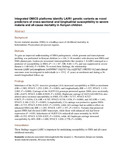| dc.description.abstract | Background
Severe malarial anaemia (SMA) is a leading cause of childhood mortality in holoendemic Plasmodium falciparum regions.
Methods
To gain an improved understanding of SMA pathogenesis, whole genome and transcriptome profiling was performed in Kenyan children (n = 144, 3–36 months) with discrete non-SMA and SMA phenotypes. Leukocyte associated immunoglobulin like receptor 1 (LAIR1) emerged as a predictor of susceptibility to SMA (P < 1 × 10−2, OR: 0.44–1.37), and was suppressed in severe disease (−1.69-fold, P = 0.004). To extend these findings, the relationship between LAIR1 polymorphisms [rs6509867 (16231C>A); rs2287827 (18835G>A)] and clinical outcomes were investigated in individuals (n = 1512, <5 years) at enrolment and during a 36-month longitudinal follow-up.
Findings
Inheritance of the 16,231 recessive genotype (AA) increased susceptibility to SMA at enrolment (OR = 1.903, 95%CI: 1.252–2.891, P = 0.003), and longitudinally (RR = 1.527, 95%CI: 1.119–2.083, P = 0.008). Carriage of the 18,835 GA genotype protected against SMA cross-sectionally (OR = 0.672, 95%CI: 0.480–0.9439, P = 0.020). Haplotype carriage (C16231A/G18835A) also altered cross-sectional susceptibility to SMA: CG (OR = 0.717, 95%CI: 0.527–0.9675, P = 0.034), CA (OR = 0.745, 95%CI: 0.536–1.036, P = 0.080), and AG (OR = 1.641, 95%CI: 1.160–2.321, P = 0.005). Longitudinally, CA carriage was protective against SMA (RR = 0.715, 95%CI: 0.554–0.923, P = 0.010), while AG carriage had an additive effect on enhanced SMA risk (RR = 1.283, 95%CI: 1.057–1.557, P = 0.011). Variants that protected against SMA had elevated LAIR1 transcripts, while those with enhanced risk had lower expression (P < 0.05). Inheritance of 18,835 GA reduced all-cause mortality by 44.8% (HR = 0.552, 95%CI: 0.329–0.925, P = 0.024), while AG haplotype carriage increased susceptibility by 68% (HR = 1.680, 95%CI: 1.020–2.770, P = 0.040).
Interpretation
These findings suggest LAIR1 is important for modulating susceptibility to SMA and all-cause childhood mortality.
Keywords: Leukocyte associated immunoglobulin like receptor 1, Plasmodium falciparum malaria, Severe malarial anaemia, All-cause mortality | en_US |
| dc.subject | Integrated, OMICS, platforms, identify, LAIR1, genetic, variants , novel, predictors, cross-sectional, longitudinal, susceptibility, severe malaria , all-cause, mortality | en_US |

